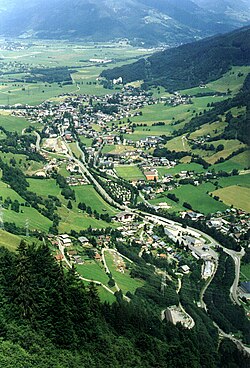Kaprun
| Kaprun | ||
|---|---|---|

Kaprun aerial view
|
||
|
||
| Location within Austria | ||
| Coordinates: 47°16′21″N 12°45′34″E / 47.27250°N 12.75944°ECoordinates: 47°16′21″N 12°45′34″E / 47.27250°N 12.75944°E | ||
| Country | Austria | |
| State | Salzburg | |
| District | Zell am See | |
| Government | ||
| • Mayor | Manfred Gaßner (SPÖ) | |
| Area | ||
| • Total | 100.41 km2 (38.77 sq mi) | |
| Elevation | 786 m (2,579 ft) | |
| Population (1 January 2016) | ||
| • Total | 3,154 | |
| • Density | 31/km2 (81/sq mi) | |
| Time zone | CET (UTC+1) | |
| • Summer (DST) | CEST (UTC+2) | |
| Postal code | 5710 | |
| Area code | 06547 | |
| Vehicle registration | ZE | |
| Website | www.kaprun.at | |
Kaprun is a municipality in the Zell am See District in the state of Salzburg, Austria. The town is an important tourist destination known as "Zell am See-Kaprun" with the neighbouring Zell am See and well known for the glacier Kitzsteinhorn.
It is located in the historic Pinzgau region on the northern slopes of the Alpine Glockner Group with Mt. Großes Wiesbachhorn, 3,564 m (11,693 ft), part of the Hohe Tauern range forming the border of Salzburg with Carinthia. At the foot of the Kitzsteinhorn Glacier, Kaprun is a year-round sports centre. The Kapruner Ache creek joins the Salzach River south of the settlement.
The Mooserboden hydroelectric plant uses water from two reservoirs held back by some of Austria’s largest dam walls. The reservoir area has become a tourist attraction, giving spectacular views over the towns of Kaprun and Zell am See. The visitors centre gives guided tours of the area. Tauern Spa World was completed in November 2010, and is the second largest spa complex in Austria. It is an 2-hour transfer to resort from Salzburg Airport.
A Chataprunnin (derived from Celtic for "whitewater") settlement in the Duchy of Bavaria was first mentioned in a 931 deed, documented as a possession held by the Counts of Falkenstein in 1166. Chaprunne Castle was acquired by the Prince-Archbishops of Salzburg in 1287 and enfeoffed to the Lords of Felben in 1338. Seat of a Salzburg burgrave from 1480, it was devastated during the 1526 German Peasants' War. In 1606 Archbishop Wolf Dietrich Raitenau had the local burgrave beheaded for siding with local insurgents. In the early 20th century the castle was a possession of Prince Johann II of Liechtenstein, who sold it in 1921.
...
Wikipedia


